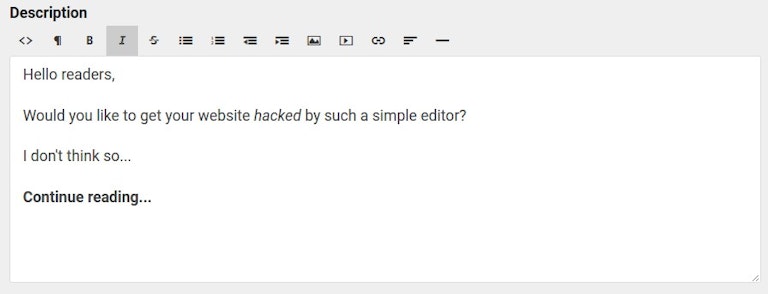Sanitizing html input: youtube iframes, css inline styles and customization
… and check why 5600+ Rails engineers read also this
Sanitizing html input: youtube iframes, css inline styles and customization
Sometimes we give users tremendous power over the content generated on the web platforms that we write. The power to add content using HTML/WYSIWYG editors.

There is only one gotcha. We need to make sure that this power is not abused by malicious users. After all, you are a responsible developer, right?
One of the libraries that you can use for that is the Sanitize ruby gem .
Sanitize.clean(html)
Why it matters
Most importantly to avoid XSS attacks.
You are probably already aware of them and know of the danger.
And to avoid CSS Injection attacks.
They can be used to lead the customer to an unsafe page outside of your website without the customer being aware of that. Imagine that your shopping platform allows people to buy products. When people click a “buy” button somewhere outside a product description they might think they are still on your page. But malicious attacker can use CSS and HTML to place identically looking button at the same location on the page that your original button is placed on.
User can click such button and be redirected to their own domain with layout identical to your shopping platform. They might think they are logging in or buying on your platform but instead they are providing their login and password or credit card credentials on the attacker page.
Youtube iframe
But sometimes you want to include or exclude some parts of the HTML conditionally. For example
you might not want the user to be able to include all <iframe>-s but you might want them
to be able to include youtube videos of cats or ted.com talks.
class IframeWhiteList
def initialize(src, attributes)
@src = src
@attributes = attributes
end
def call(env)
node = env[:node]
node_name = env[:node_name]
# Don't continue if this node is already whitelisted or is not an element.
return if env[:is_whitelisted] || !node.element?
# Don't continue unless the node is an iframe.
return unless node_name == 'iframe'
# Verify that the video URL is actually a valid video URL.
return unless node['src'] =~ @src
# We're now certain that this is a valid embed, but we still need to run
# it through a special Sanitize step to ensure that no unwanted elements or
# attributes that don't belong in a YouTube embed can sneak in.
Sanitize.clean_node!(node, {
:elements => %w[iframe],
:attributes => {'iframe' => @attributes}
})
# Now that we're sure that this is a valid embed and that there are
# no unwanted elements or attributes hidden inside it, we can tell Sanitize
# to whitelist the current node.
{:node_whitelist => [node]}
end
end
class YouTubeWhiteList < IframeWhiteList
def initialize
super(
/\A(https?:)?\/\/(?:www\.)?youtube(?:-nocookie)?\.com\//,
%w(
allowfullscreen frameborder height src width scrolling
webkitallowfullscreen mozallowfullscreen
style title id name seamless
allowtransparency hspace vspace marginheight
marginwidth border
)
)
end
end
Sanitize.clean(@html, Sanitize::Config::RELAXED.merge(transformers: [
YouTubeWhiteList.new,
TedCom.new
])
Be very careful when defining the regexp for the URL and make sure to write some tests. If you forget to escape one character (for example a dot) the attacker can embed an iframe from similarly looking domain.
let(:html) do
%q{
<iframe src="//wwwXyoutube.com/embed/IqajIYxbPOI"></iframe>
<iframe src="//www.youtubeXcom.com/embed/IqajIYxbPOI"></iframe>
}
end
it { expect(html_description.sanitized.strip).to eq("") }
And be careful to write tests for the attributes:
let(:html) do
%q{<iframe width="560" height="315" src="//www.youtube.com/embed/IqajIYxbPOI"
frameborder="0" allowfullscreen style="box-sizing: border-box;">
</iframe>
}
end
it { expect(html_description.sanitized).to eq(
%q{<iframe width="560" height="315" src="//www.youtube.com/embed/IqajIYxbPOI"
frameborder="0" allowfullscreen>
</iframe>
}
) }
Allowing inline styles
For allowing certain styles you might want to use HTML::WhiteListSanitizer that comes
from your Rails 4.1 or Rails::Html::WhiteListSanitizer from rails-html-sanitizer gem
in later versions (which under the hood uses loofah gem).
Allowing and sanitizing inline styles might be required for your editor to work properly.
class CssStyleCheck
class Sanitizer < HTML::WhiteListSanitizer
self.allowed_css_properties = HTML::WhiteListSanitizer.
allowed_css_properties + %w(border-style border-width)
end
def initialize
@sanitizer = Sanitizer.new
end
def call(env)
node = env[:node]
node_name = env[:node_name]
return if env[:is_whitelisted] || !node.element? || !node['style']
node['style'] = @sanitizer.sanitize_css(node['style'])
end
end
Sanitize.clean(html, Sanitize::Config::RELAXED.merge(transformers: [
CssStyleCheck.new,
])
Make sure to test it as well. I usually test that all allowed attributes/styles are left unchanged and some of the disallowed (after all the list is infinite…) are removed:
let(:html) do
%q{<div style="background-color: 1px; border-bottom-color: 1px;"></div>}
end
it { expect(html_description.sanitized).to eq(html) }
let(:html) do
%q{<div style="background-color: black; min-width: 10px;
mso-pagination:none; box-sizing: border-box;">
</div>
}
end
it { expect(html_description.sanitized).to eq(
%q{<div style="background-color: black;"></div>})
}
Relaxing even more
Even though the list of HTML tags and attributes allowed by Sanitizer is quite long, you
might still want to customize it a bit depending on your needs and the
way the editor of your choice works.
def self.relaxed_config_hash_deep_copy
Marshal.load(Marshal.dump(Sanitize::Config::RELAXED))
end
Config = relaxed_config_hash_deep_copy.tap do |config|
config[:elements] += %w(hr)
config[:attributes][:all] += %w(border)
config[:attributes]["a"] += %w(target)
end.freeze
Sanitize.clean(html, Config)
Note
The examples are using sanitize in version 2.1.